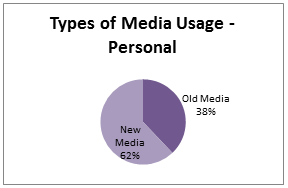Journalism and communication has started to see a shift from
the use of old media, namely newspapers, magazines, radio and television, to new
media, which revolves around the internet. As such, media platforms have had to
change from traditional forms to online ones. The rise of new media usage is
the topic of this dossier.
I logged my media usage for ten days (figure 1.0), and then
compared it to the results of the survey.
 |
| Figure 1.0 |
The
majority of media used was online, with online news and Facebook having the
highest total time. Blogging, magazines and television were also used a lot,
though their time was nearly half of that seen for Facebook.
This
preference for new media was not seen in the survey results however. In the
survey, more old media was used than new media (figure 2.0). This conflicts in
comparison to my media usage (figure 3.0), where it can be seen that new media
was used more.
 |
| Figure 2.0 |
 |
| Figure 3.0 |
While these results indicate that I use a much higher amount
of new media than average, the time I spent online each day was significantly
less than that seen in the survey. I spent approximately 45 minutes online each
day, whereas the average was 1-3 hours. Also, television was the main way
people got their news, whereas my main form of news was online newspapers.
These differences could be attributed to the fact that
online platforms are easier for me to access than other media forms. Online
news made up the biggest percentage of my media use, followed by Facebook, another
easily accessed form. These results do have some similarities with the survey
results however, as the second biggest source of news was online newspapers,
and 91.1% of the time people spent online was on Facebook. My media usage,
therefore, does have some similarities with the survey.
 |
| Figure 4.0 |
Usage versus producage was created with web 2.0. Produsage
can be defined as:
“…the
collaborative, iterative, and user-led production of content by participants in
a hybrid user-producer, or produser role.” (Bruns, 2005).
Approximately 22% of my interaction with media
was producage, as can be seen in figure 4.0. This included Facebook posts,
tweets, and blogging. In regards to the survey results, while it is hard to
determine exactly when people use and produce media, the fact that 97.2% of
individuals have one or more Facebook accounts, 32.3% use Twitter and 41.4%
have blogs indicates produsage. These statistics show that produsage is
becoming a big part of media, and therefore journalism, with individuals being able
to participate in media production.
These trends indicate that the way people use media is
changing, with new media forms and produsers affecting media consumption and
production. In regards to my media usage, it can be seen that my relationship
with journalism is mostly in new media, and that I not only use but also
produse. This indicates that generally, media is starting to encompass new
forms, and that people are engaging with them in new ways.
References
Bruns, A. (2005). Towards
Produsage: Futures for User-Led Content Production. [available online] http://snurb.info/files/12132812018_towards_produsage_0.pdf
last accessed: 29/03/12
No comments:
Post a Comment